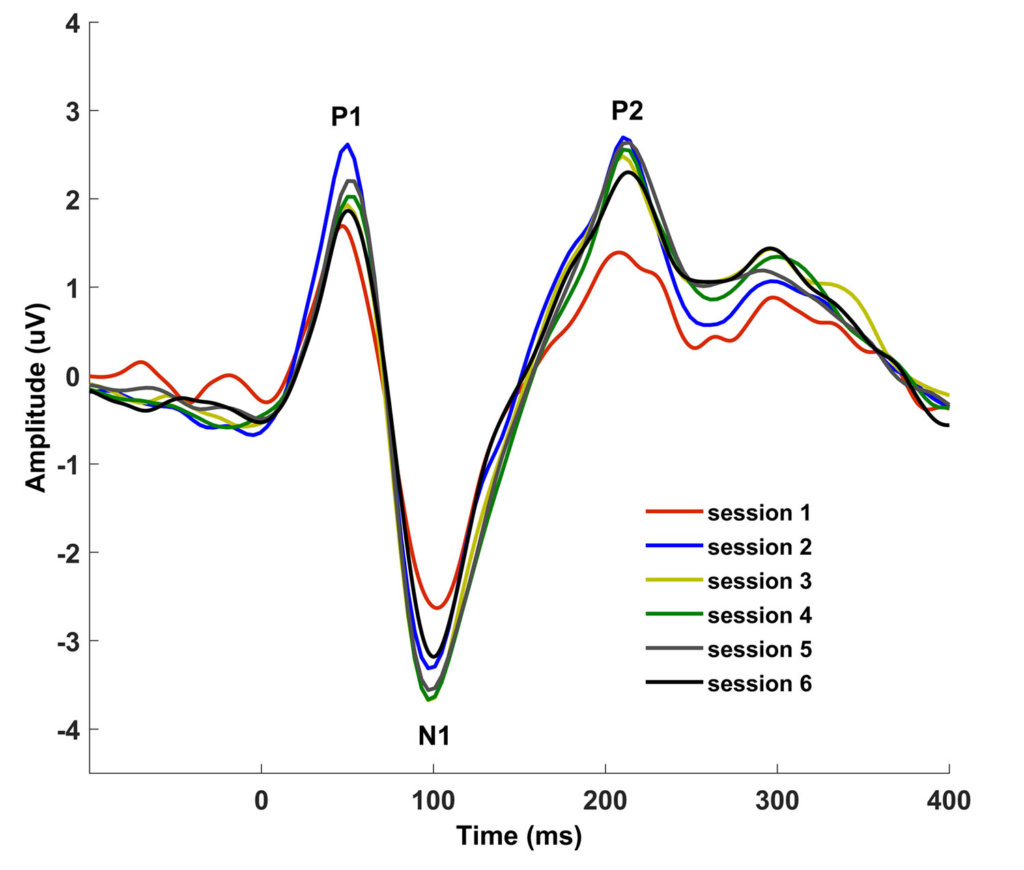Mysteries of the Hearing Brain: Hearing Aid Use Improves Brain Processing Over Time
New hearing aid users often report significant improvements in quality of life as they connect once again to the hearing world around them. Yet, first-time hearing aid users may find newly amplified sounds overwhelming. The onset of hearing loss usually occurs slowly, and individuals may wait seven or more years before deciding to pursue treatment for hearing loss. During this time, the brain adjusts to the lack of sound input by increasing the firing rate of auditory neurons, making them more excitable. This increased excitability can make newly amplified sounds seem uncomfortably loud. Fortunately, the brain can readjust to an increase in auditory input through hearing aids. This adjustment period takes time, however, and knowledge of the time course of neural adaptation may be useful when counseling patients who are fit with hearing aids for the first time.
Several studies have examined neural plasticity induced by hearing aid use over 4 weeks to six months with varied results. The amplitude of the P3 cortical component, elicited with an oddball electrophysiology paradigm, was reduced after 4 to 12 weeks of hearing aid use in newly fitted patients (Giroud et al., 2017; Rao et al., 2017). In contrast, 12 weeks of hearing aid use did not lead to changes in the cortical response’s P1, N1, and P2 peaks (Dawes et al., 2014). Cortical peaks represent different stages of processing and cognitive/linguistic engagement. Different processing stages may require more extended periods of neural adaptation once hearing aid amplification is introduced.
In 2014, my lab was awarded a Hearing Health Foundation grant to evaluate neural plasticity associated with hearing aid use, and we focused on the earlier pre-conscious cortical peaks: P1, N1, and P2. These peaks represent detection of the signal, attention to the signal, and pre-conscious identification of the signal. We recruited listeners with mild-to-moderate sensorineural hearing loss who had never worn hearing aids and randomly assigned them to two groups. The first group of 17 individuals was fit with hearing aids and wore them for at least eight hours a day for six months. The second group of 14 individuals was fit and tested with hearing aids but did not wear them during the six months. We recorded cortical responses to the speech syllable /ga/ while the participants wore appropriately fitted hearing aids at six time points: initial fitting, two weeks, six weeks, twelve weeks, eighteen weeks, and six months post-hearing aid fitting. Our initial findings were limited to comparisons obtained at the initial fitting and at the six-month post visits. They showed that N1 and P2 amplitudes increased, but there were no changes in peak latency (Karawaniet al., 2018). These changes were not observed in the no hearing aid use group.
We recently published a follow-up study to determine the time course of these changes in peak amplitudes (Karawaniet al., 2022). We found that the early stages of neural processing changed rapidly. The amplitude of N1 increased after just two weeks. Later stages of brain processing required more time to observe a consistent change. Peak P2 of the cortical response signals the brain’s early identification of an auditory stimulus. For example, if one hears the sound of a toilet flushing, the brain forms an auditory image of a toilet at an unconscious level. Increases in P2 amplitude were observed after six weeks of hearing aid use. Figure 1 displays changes in these amplitudes for six sessions.

So, what does this mean for the new hearing aid user? The brain adjusts quickly to amplified sound – that’s a good thing. But the brain’s ability to fully interpret amplified signals in a meaningful way requires a more extended time. The typical hearing aid trial period is thirty days, so the hearing aid user may not be experiencing the full benefits of amplification at the end of the trial. The audiologist may wish to use this information to counsel the patient that hearing through amplification should continue improving, especially regarding clarity. Karawani et al. (2022) also found that electrophysiology testing on the first day of hearing aid fitting predicted later improvements. Perhaps in the future, we will see an increase in the use of electrophysiology to manage hearing loss and counsel patients regarding appropriate expectations.
References
- Dawes, P., Munro, K. J., Kalluri, S., and Edwards, B. (2014). “Auditory acclimatization and hearing aids: late auditory evoked potentials and speech recognition following unilateral and bilateral amplification,” J Acoust Soc Am 135, 3560-3569.
- Giroud, N., Lemke, U., Reich, P., Matthes, K. L., and Meyer, M. (2017). “The impact of hearing aids and age-related hearing loss on auditory plasticity across three months – An electrical neuroimaging study,” Hear Res 353, 162-175.
- Karawani, H., Jenkins, K., and Anderson, S. (2018). “Restoration of sensory input may improve cognitive and neural function,” Neuropsychologia 114, 203-213.
- Karawani, H., Jenkins, K., and Anderson, S. (2022). “Neural Plasticity Induced by Hearing Aid Use,” Front Aging Neurosci 14, 884917.
- Rao, A., Rishiq, D., Yu, L., Zhang, Y., and Abrams, H. (2017). “Neural correlates of selective attention with hearing aid use followed by readmyquips auditory training program,” Ear Hear 38, 28-41.

